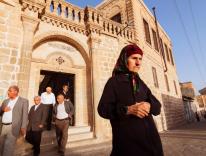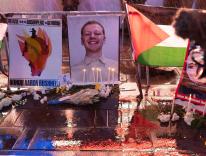
On my way to catch the annual Christmas show at Radio City Music Hall, I stopped off to listen in on a gathering held at the Church Center for the United Nations. I can report that the Christmas Spectacular is indeed spectacular, all the more so because of state-of-the-art technology that transforms the ceilings and walls of that massive cathedral of entertainment into a canvas for animated Christmas imaginings. The living Christmas crèche was very good, too—what that showman Francis of Assisi might have done if he had access to multimedia technology.
As wonderful as that was, I ended the day thinking about what I’d seen in the morning, in a meeting room that looked out on the many national flags lining the perimeter of the United Nations headquarters across the street. For if Christmas is to be about the leopard and the kid laying down together, or the wolf and the lamb, or the swords beaten into ploughshares, or the child to be known as Prince of Peace, then what I saw at the UN was also a Christmas event.
A group called Rondine Cittadella della Pace—Citadel of Peace—was visiting the UN from Italy to seek international support for its efforts to train young people in the art of reconciling enemies. It turned Rondine, an abandoned village in Tuscany, into a base where young people come from regions divided by conflict to study and get to know each other. The students commit to two years of training, and to living with people they most likely grew up viewing as enemies: Israelis and Palestinians, for example, and students from many other conflict zones such as Georgia, Chechnya, Sierra Leone, Mali, Lebanon, Kosovo, Sudan, and Colombia.
The Rondine Method, as the group calls it, is built on person-to-person contact. The medieval hamlet on the banks of the River Arno becomes a neutral ground where pairs of young people from opposing sides in a conflict can gradually set aside the cultural and historical grievances they grew up with and learn to see each other as human beings, rather than as presumed enemies. “We start with the idea that we are all human,” the group’s president, Franco Vaccari, said in Italian during the December 11 panel discussion sponsored by Caritas Internationalis.
As part of the leadership training, the students learn Italian—which means their conversations will be in a neutral language. As the training continues, the students are taught to deconstruct the social constructs that reinforce enmity.
“It is a two-year program that enables you to see the other,” said Manuella Markaj, a native of Kosovo who completed the training and now serves as director of Rondine’s two-hundred-member alumni association. She was nine years old when war broke out in Kosovo in 1998. As a college student, her views began to change when she met some Serbian students, the one-time enemy. At Rondine, she said, she developed the skills for reconciliation, and also studied for a master’s degree at the University of Bologna.
Another Rondine alum, thirty-two-year-old Anthony Kamara, was a child soldier during the civil war in Sierra Leone; he told me that his role was to carry ammunition. Last March, Kamara and Markaj took part in an initiative to encourage peaceful, democratic elections in Sierra Leone. In a country shaking off the demons of an eleven-year civil war, they prepared trainers to develop hundreds of community leaders in each tribe and region of the country. Their mission was to create the trust that allows for nonviolent, democratic elections and the peaceful transfer of power—a process that began with meeting the presumed enemy. “We had to practice what we learned in Rondine,” said Kamara, now a professor of finance in Sierra Leone. He said that with help from the religious community, he started dialogue with one-time rebel leaders.
The Rondine association has received a fair amount of news coverage in Italy, but is not well known in the United States. It did catch the eye of Miguel Díaz, U.S. ambassador to the Holy See during President Barack Obama’s first term and a professor of theology at Loyola University Chicago.
Díaz was spending the week with the visitors from Rondine as they took part in a series of events in New York and Washington. He told me that he had invited young people from Rondine to tell their stories to diplomats during a ceremony the embassy held in 2011 for the tenth anniversary of the 9/11 attack. “It’s everything I believe in terms of building bridges,” he said.
Before departing for New York, the Rondine association met with Pope Francis on December 3 at the Vatican to mark its twentieth anniversary. He applauded the young people for getting involved in Rondine “when everything around you and inside you said: But why?”
The group previewed an appeal it would make at a United Nations event on December 10—represented by one Palestinian and one Israeli student—as part of a ceremony marking the seventieth anniversary of the Universal Declaration of Human Rights.
“There is a need for leaders with a new mentality,” Francis said in reply. “Those who do not know how to dialogue and exchange with each other are not leaders of peace: a leader who does not try to meet the ‘enemy,’ to sit with him at the table as you do, cannot lead his people to peace. To do this we need humility, not arrogance: Saint Francis helps you to follow this path with courage.”
The Rondine association takes its inspiration from the saint from Assisi, particularly from his prayer at La Verna, which is about twenty-five miles from Rondine. It is the forested mount where Francis experienced the mystic vision said to have caused his stigmata—the “mystery of pain and love,” as Vaccari told me.
Rondine’s method of reaching out to the other, to the enemy, reminded me much of Francis’s encounter with Egypt’s Sultan Malik al-Kamil in the midst of the Fifth Crusade in 1219. Even more so, I see a Franciscan antecedent for Rondine in the story of the wolf of Gubbio, in which Francis brings together a fearsome wolf and the townspeople the wolf terrorized. He made both parties to the conflict see the other’s suffering—the townspeople, too, had failed, since they had failed to love the enemy. They recognized that hunger caused the wolf’s violence but had done nothing to slake it. Instead, they resorted to violence, which caused more violence.
I take that story as a fable (it didn’t emerge until long after Francis’s death), but one crafted very carefully to show future generations St. Francis’s method for achieving peace on earth: good will to all.
Please email comments to [email protected] and join the conversation on our Facebook page.
Share
Previous Story
Poem | Eventual Surface
Next Story
LGBT Catholics Are a Reality

